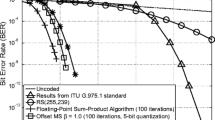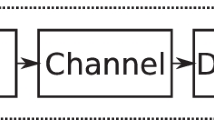Abstract
A new parameterized-core-based design methodology targeted for programmable decoders for low-density parity-check (LDPC) codes is proposed. The methodology solves the two major drawbacks of excessive memory overhead and complex on-chip interconnect typical of existing decoder implementations which limit the scalability, degrade the error-correction capability, and restrict the domain of application of LDPC codes. Diverse memory and interconnect optimizations are performed at the code-design, decoding algorithm, decoder architecture, and physical layout levels, with the following features: (1) Architecture-aware (AA)-LDPC code design with embedded structural features that significantly reduce interconnect complexity, (2) faster and memory-efficient turbo-decoding algorithm for LDPC codes, (3) programmable architecture having distributed memory, parallel message processing units, and dynamic/scalable transport networks for routing messages, and (4) a parameterized macro-cell layout library implementing the main components of the architecture with scaling parameters that enable low-level transistor sizing and power-rail scaling for power-delay-area optimization. A 14.3 mm2 programmable decoder core for a rate-1/2, length 2048 AA-LDPC code generated using the proposed methodology is presented, which delivers a throughput of 6.4 Gbps at 125 MHz and consumes 787 mW of power.
Similar content being viewed by others
References
N. Wiberg, “Codes and Decoding on General Graphs,” Ph.D. thesis, Linkoping University, Sweden, 1996.
R.G. Gallager, Low-Density Parity-Check Codes, Cambridge, MA: MIT Press, 1963.
C. Berrou, A. Glavieux, and P. Thitimajshima, “Near Shannon Limit Error-Correcting Coding and Decoding: Turbo Codes,” in IEEE Int. Conf. on Communications, 1993, pp. 1064–1070.
M.M. Mansour and N.R. Shanbhag, “Turbo Decoder Architectures for Low-Density Parity-Check Codes,” in Proc. IEEE Global Telecomm. Conf. 2002 (GLOBECOM’02), Taipei, Taiwan, Nov. 2002, pp. 1383–1388.
C. Rowland and A. Blanksby, “Parallel Decoding Architectures for Low Density Parity Check Codes,” in Proc. of 2001 IEEE Int. Symp. on Circuits and Systems, Sydney, May 2001, pp. 742–745.
M.M. Mansour, “VLSI Architectires for Iterative Channel Decoders,” Ph.D. thesis, University of Illinois at Urbana-Champaign, USA, 2003.
E. Yeo et al., “VLSI Architectures for Iterative Decoders in Magnetic Recording Channels,” IEEE Trans, on Magnetics, vol. 37, no. 2, 2001, pp. 748–755.
M.M. Mansour and N.R. Shanbhag, “Low-Power VLSI Decoder Architectures for LDPC Codes,” in Proc. IEEE Int. Sympos. on Low Power Electronics and Design (ISLPED’02), Monterey, CA, Aug. 2002, pp. 284–289.
M.M. Mansour and N.R. Shanbhag, “Memory-Efficient Turbo Decoder Architectures for LDPC Codes,” in IEEE Workshop on Signal Processing Systems 2002 (SIPS’02), San Diego, CA, Oct. 2002, pp. 159–164.
M.M. Mansour and N.R. Shanbhag, “High-Throughput LDPC Decoders,” IEEE Transactions on VLSI Systems, vol. 11, no. 6, 2003, pp. 976–996.
M.M. Mansour and N.R. Shanbhag, “Construction of LDPC Codes from Ramanujan Graphs,” in Conf. on Info. Sciences and Systems, Princeton University, March 2002.
L.R. Bahl, J. Cocke, F. Jelinek, and J. Raviv, “Optimal Decoding of Linear Codes for Minimizing Symbol Error Rate,” IEEE Trans. on Info. Theory, March 1974, pp. 284–287.
X.Y. Hu et al., “Efficient Implementations of the Sum-Product Algorithm for Decoding LDPC Codes,” in GLOBECOM 2001, vol. 2, 2001, pp. 1036–1036E.
M.M. Mansour, M.M. Mansour, and A. Mehrotra, “Modified Sakurai-Newton Current Model and its Applications to CMOS Digital Circuit Design,” in IEEE Computer Society Annual Syposium on VLSI, Feb. 2003, pp. 62–29.
Author information
Authors and Affiliations
Corresponding author
Additional information
Mohammad M. Mansour received his B.E. degree with distinction in 1996 and his M.S. degree in 1998 all in Computer and Communications Engineering from the American University of Beirut (AUB). In August 2002, he received his M.S. degree in Mathematics from the University of Illinois at Urbana-Champaign (UIUC). Mohammad received his Ph.D. in Electrical Engineering in May 2003 from UIUC. He is currently an Assistant Professor of Electrical Engineering with the ECE department at AUB. From 1998 to 2003, he was a research assistant at the Coordinated Science Laboratory (CSL) at UIUC. In 1997 he was a research assistant at the ECE department at AUB, and in 1996 he was a teaching assistant at the same department. From 1992–1996 he was on the Dean’s honor list at AUB. He received the Harriri Foundation award twice in 1996 and 1998, the Charli S. Korban award twice in 1996 and 1998, the Makhzoumi Foundation Award in 1998, and the PHI Kappa PHI Honor Society awards in 2000 and 2001. During the summer of 2000, he worked at National Semiconductor Corp., San Francisco, CA, with the wireless research group. His research interests are VLSI architectures and integrated circuit (IC) design for communications and coding theory applications, digital signal processing systems and general purpose computing systems.
Naresh R. Shanbhag received the B.Tech from the Indian Institute of Technology, New Delhi, India, in 1988, M.S. from Wright State University and Ph.D. degree from the University of Minnesota, in 1993, all in Electrical Engineering. From July 1993 to August 1995, he worked at AT&T Bell Laboratories at Murray Hill in the Wide-Area Networks Group, where he was responsible of development of VLSI algorithms, architectures and implementation for high-speed data communications applications. In particular, he was the lead chip architect for AT&T’s 51.84 Mb/s transceiver chips over twisted-pair wiring for Asynchronous Transfer Mode (ATM)-LAN and broadband access. Since August 1995, he is with the Department of Electrical and Computer Engineering, and the Coordinated Science Laboratory where he is presently an Associate Professor and Director of the Illinois Center for Integrated Microsystems. At University of Illinois, he founded the VLSI Information Processing Systems (ViPS) Group, whose charter is to explore issues related to low-power, high-performance, and reliable integrated circuit implementations of broadband communications and digital signal processing systems. He has published numerous journal articles/book chapters/conference publications in this area and holds three US patents. He is also a co-author of the research monograph Pipelined Adaptive Digital Filters (Norwell, MA: Kluwer, 1994). Dr. Shanbhag received the 2001 IEEE Transactions Best Paper Award, 1999 Xerox Faculty Research Award, 1999 IEEE Leon K. Kirchmayer Best Paper Award, the 1997 Distinguished Lecturer of IEEE Circuit and Systems Society (97–99), the National Science Foundation CAREER Award in 1996, and the 1994 Darlington Best Paper Award from the IEEE Circuits and Systems society. From 1997–99 and 2000–2002, he served as an Associate Editor for IEEE Transaction on Circuits and Systems: Part II and an Associate Editor for the IEEE Transactions on VLSI, respectively. He was the technical program chair for the 2002 IEEE Workshop on Signal Processing Systems (SiPS02).
Rights and permissions
About this article
Cite this article
Mansour, M.M., Shanbhag, N.R. A Novel Design Methodology for High-Performance Programmable Decoder Cores for AA-LDPC Codes. J VLSI Sign Process Syst Sign Image Video Technol 40, 371–382 (2005). https://doi.org/10.1007/s11265-005-5271-5
Received:
Revised:
Accepted:
Published:
Issue Date:
DOI: https://doi.org/10.1007/s11265-005-5271-5




